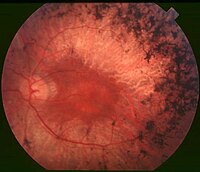
Photo from wikipedia
Background: This study analyzed the phenotypes and genotypes of 41 Chinese families with inherited retinal dystrophy (IRD) and RPGR gene mutations. Methods: This retrospective analysis evaluated a cohort of 41… Click to show full abstract
Background: This study analyzed the phenotypes and genotypes of 41 Chinese families with inherited retinal dystrophy (IRD) and RPGR gene mutations. Methods: This retrospective analysis evaluated a cohort of 41 patients who were subjected to a specific Hereditary Eye Disease Enrichment Panel (HEDEP) analysis. All (likely) pathogenic variants were determined by Sanger sequencing, and co-segregation analyses were performed on the available family members. All cases were subjected to Sanger sequencing for RPGR open reading frame 15 (ORF15) mutations. Results: A total of 41 probands from different families with a clinical diagnosis of retinitis pigmentosa (RP; 34 cases) and cone-rod dystrophy (CORD; 7 cases) were included in this cohort. According to clinical information, 2, 18, and 21 cases were first assigned as autosomal dominant (AD), sporadic, and X-linked (XL) inheritance, respectively. Several cases of affected females who presented with a male phenotype have been described, posing challenges at diagnosis related to the apparent family history of AD. Mutations were located in RPGR exons or introns 1–14 and in ORF15 of 12 of 41 (29.3%) and 29 of 41 (70.7%) subjects, respectively. Thirty-four (likely) pathogenic mutations were identified. Frameshifts were the most frequently observed variants, followed by nonsense, splice, and missense mutations. Herein, a detailed description of four RP patients carrying RPGR intronic mutations is reported, and in vitro splice assays were performed to confirm the pathogenicity of these intronic mutations. Conclusion: Our findings provide useful insights for the genetic and clinical counseling of patients with XL IRD, which will be useful for ongoing and future gene therapy trials.
Journal Title: Frontiers in Genetics
Year Published: 2022
Link to full text (if available)
Share on Social Media: Sign Up to like & get
recommendations!